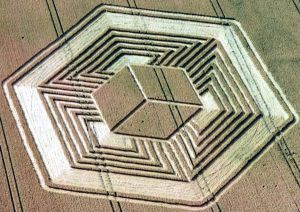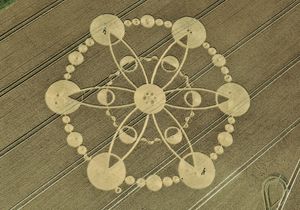

Courtesy www.cropcircleconnector.com.
In the summer of 2010, the opportunity arose to visit several crop formations in the fields of England. On two occasions, a number of photographs were taken with an inexpensive digital camera that had been modified to be most sensitive to the near infrared part of the spectrum. To accomplish this, the optical filter in the camera was replaced with a piece of exposed color film. The camera is now insensitive to light in the visible spectrum, but is still sensitive to a part of the light spectrum normally not visible to the human eye. For example, it can still detect the invisible output of a television infrared remote control.
The two formations shown in Figure 1 were visited on separate days. The formation near Fosbury, Wiltshire, was examined on July 22 when the formation was already more than a week old. The air was very humid with occasional sprinkles of rain. The second formation near Windmill Hill, Wiltshire, was examined on July 28 when it was only about one day old. This time the weather was sunny and warm.
 |
 |
Figure 1. TheFosbury (left) and Windmill Hill (right) formations. Courtesy www.cropcircleconnector.com. |
Photographs were taken haphazardly in all directions while standing in the formation. Several pictures contained apparent anomalies, some more interesting than others. Each row of the following Table 1 shows the original photo, the photo enhanced via equalization, and relevant comments. The pictures are presented in the order they were taken.
In a near infrared photo, brighter areas emit light with wavelengths somewhat longer than light in the visible electromagnetic spectrum. Such areas are not necessarily warm to the touch. Thus, we cannot say that the brighter areas seen in the above images were warmer than the surrounding areas. We can say only that the the bright areas were good emitters or reflectors of light having near infrared wavelengths.
The above Images 1 and 2 show blobs of white that might be reflections from physical objects brought into the formation by visitors. Whether or not they are actual anomalies is therefore inconclusive.
The effects seen in Images 3 and 4 are not as easy to explain. In Image 4, the proximity of the white clouds to the smaller circles suggests that there may be a connection between them. That is, the process that created the circle may also have left a region of space above the circle that is an infrared emitter. The transparent sphere in Image 3 may be a similar residual effect. Since it seems to have had a physical effect on the crop, judging from the corresponding depression in the crop surface, it may even have been part of a mechanism employed to push down the standing crop.
It should be noted that a similar anomaly in an infrared photo of a crop formation has already been seen. A report entitled "Robbert van den Broeke: "UFO" Photos" by Nancy Talbot shows an infrared photo of a 2008 crop formation in the Netherlands. The image, reproduced in Figure 2, clearly shows white balls of light hovering over the circles. Talbot speculates that some anomalies appearing in photos when Robbert is present might be projected onto the image from Robbert's subconscious mind, and the objects might not be physically present in front of the camera. On the other hand, these spherical objects may have been real since there is a correspondence between Robbert's picture and the Windmill Hill photos. It is possible that the spheroidal anomaly of Image 3 is a faded version of the spherical shape in Figure 2, and the cloud-like infrared sources over the circles in Image 4 may originally have been spherical as well.
 |
Figure 2. Infrared photo showing balls of light hovering over crop circles. Courtesy www.bltresearch.com; Photo by Robbert van den Broeke. |